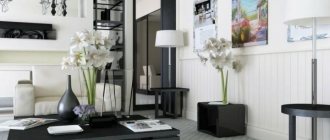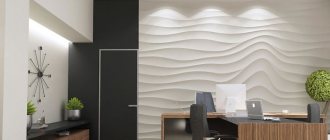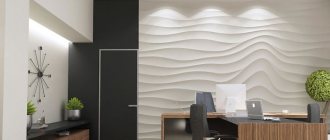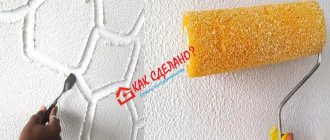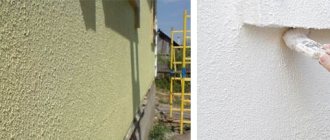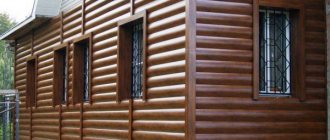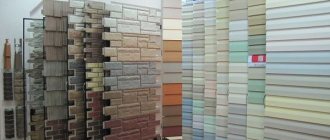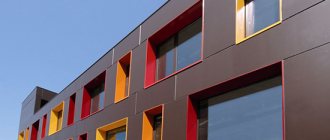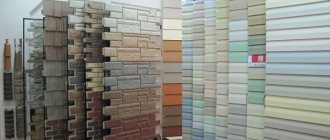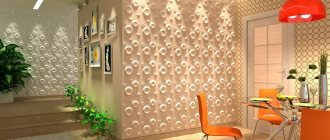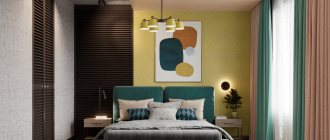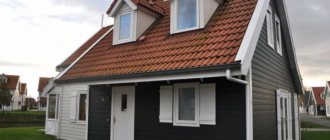The abbreviation MDF stands for medium density fiberboard. The entire production process is based on pressing finely dispersed fractions of wood chips under pressure. High temperatures promote the release of tree resin, which glues wood fibers together. Thanks to its manufacturing technology, MDF has:
- Environmentally friendly and exceptionally safe, no harmful substances or unpleasant odors are released during operation. MDF is suitable for use in residential premises and children's rooms.
- Strength, which eliminates sagging of wide shelves. The panels can withstand quite heavy loads. The ability to bend gives the furniture the desired design.
- Resistant to temperature changes and high humidity, which cannot be said about natural wood. Thanks to these qualities, the panels are used in the interior of kitchens and bathrooms.
- Immunity to mold and fungal infections, infection by microorganisms.
- Cheaper compared to natural wood and chipboard.
- Easy to install.
- Wide choice of colors.
With the help of wall panels, you can bring to life any design for the decoration of apartments and office premises. This is an excellent replacement for expensive materials. The panels can look like natural wood, plastic, textured plaster, or tiles. Covered with PVC film, the panel acquires a lacquered surface, which is widely used in furniture facades.
Advantages and disadvantages of MDF panels
Kitchen furniture covered with glossy film is very durable and designed for many years of service. In addition, panels covered with film create the appearance of a seamless coating.
The palette of colors and shades of panels opens up scope for the designer's imagination in the decoration of walls, shelving, and furniture facades.
With MDF you can create a frame with the insertion of decorative glass, mirrors, translucent plastic, eco-leather. Furniture facades finished with natural veneer look beautiful.
MDF's ability to bend radius allows you to create beautiful furniture with a smooth completion of the composition, leaving a lot of usable space in the rooms.
Furniture made from MDF does not require special care. The damaged surface of the parts can be replaced with a new one.
The disadvantages of panels include:
- ease of ignition, inadmissibility of contact with open fire;
- deformation under the influence of high temperatures, which is created by heating devices;
- instability to mechanical damage.
The hardness of the material does not allow driving nails or screws into MDF panels. All mounting holes are pre-drilled.
What does MDF look like, what are its performance characteristics, are there any differences between types
MDF panels are used widely and everywhere. Let's consider what performance characteristics of the material attract attention. In what areas of repair and finishing are they used?
How to use MDF panels for interior wall decoration
MDF panels for walls come in different sizes and three types. As a finishing material, this is a good purchase, because it cannot easily be broken or bent, and the condition of the slabs remains in its original form for a long time.
You can make good repairs with such walls: they stick well with wood glue or liquid nails
Panels can be slatted, sheet and tile. The rack type is the most common in use due to ease of installation: the ridge fits into the groove.
Sheets of different sizes give you a choice
The tile type resembles tiles, but is larger in size. Tile types are mounted in the same way as rack types.
The walls can be veneered with a 3 mm layer of veneer with imitation wood, laminated with polyvinyl chloride film, which will make the interior stylish.
Photo printing on MDF is firmly in fashion. To protect the design, an acrylic-based varnish is applied to the plates
You can find slabs with a 3D effect, which is still an innovation. This is much more interesting than simple painted panels, which allows you to create an original design in the room.
Material for ceiling and floor: MDF panels
For ceilings and floors, slabs are a suitable material due to their characteristics. Strength was mentioned above; it is worth adding that such finishing contributes to noise and sound insulation.
If you add special soundproofing materials, then there will be real silence in the apartment, and the clatter of neighbors from above and noise will become just a memory
Elegant appearance
The wood panel is ideal for laying subfloors due to its high strength, ideal evenness, and resistance to temperature changes.
This floor is not at risk of fungus and pathogens
MDF floor plinth
The finely dispersed fraction of MDF plinth and its external decorative finishing with paper impregnated with dyes make the product attractive for the finishing touch in home decoration. The manufacturing technology will not allow the decorative layer to come off over time, since a melamine coating is applied to it.
Such protection will not allow either moisture or dirt to get into the baseboard. It is also fade resistant
It has become fashionable to use white MDF baseboards: thanks to the melamine coating, dirt practically does not appear on it.
You can purchase MDF plinth for painting
Despite the positive qualities of this finishing material, its disadvantage is its fragility: it does not resist mechanical damage well enough.
MDF kitchen apron
It makes sense to consider the proposal to make a kitchen apron from MDF. Typically, a laminated or veneered version is purchased for this purpose, which turns the kitchen space into an elegant room.
Using MDF panels for the kitchen
The apron can be positioned up to the ceiling, which looks very impressive.
But, unfortunately, this material is flammable. If you want to protect yourself, you should cover the apron behind the stove with tempered glass.
Can I choose panels with a pattern? This is a budget decor, but rather unstable if the design is printed on film. And if the application was made on acrylic plastic with a protective layer of varnish, then such an apron will last longer. Alternatively, the design can be hidden under several layers of varnish, sintered together using the “hot lining” method.
Window sill laminated from MDF
The window sill is always exposed to sunlight, near open windows and heating radiators. This makes it necessary to use high-quality material for the structure, which will not need to be sanded and painted year after year in order to maintain its aesthetics and quality. Laminated MDF is reliable, good looking, and wear-resistant.
You can order various designs, the cost of such designs is not particularly high
MDF interior doors
Such products made from MDF are popular; there are two types of such structures: panel and panel.
Panel doors look like a smooth, single piece, with or without decorative inserts.
The frame of such products is made of solid pine timber placed around the perimeter. And two MDF boards are attached on top of the frame
The hollow space is filled with cardboard or hardboard. If there are many cells inside, the design is light. It's called masonite. More solid and weighty options consist exclusively of MDF inside.
Paneled interior doors are a combination of solid wood around the perimeter and inserts in the middle.
MDF sheet is laid on top. Free cells inside are covered with glass or MDF panels
The outside of the doors is lined with natural veneer, eco-veneer, PVC film, laminate or enamel. In any case, the finishing coat is varnish.
Using MDF in furniture making
Furniture and furniture facades are made from MDF. By all criteria, this is an excellent material, in addition, there is the possibility of fine processing and milling, which creates fancy shapes and elements on furniture.
The result is original products with a high level of aesthetics
The material is plastic, so you can get convex or concave furniture facades from MDF, which will be a real godsend for the designer’s ideas.
MDF kitchens in PVC film are very modern
Classification of wall panels
The industry produces several types and price categories of MDF panels.
Depending on the coating of particle boards, they are divided into:
- painted;
- laminated;
- veneered.
Painted MDF board is the cheapest. The paint protects the panels from wear, but is vulnerable to moisture. By means of painted slabs in glossy or matte finish, any design solution can be brought to life.
Laminated MDF panels are produced by covering them with polyvinyl chloride. PVC allows you to give panels the appearance of different textures, decorativeness, and a variety of color shades. Decorating the walls with panels with a slight gloss creates your own unique interior in the kitchen, living room, and bedroom.
For bathrooms, loggias, and other rooms with high humidity, moisture-resistant panels with multi-layer impregnation with water-repellent agents are used.
Veneered panels resemble wood in their appearance. During their production, the surface of the slabs is glued with the thinnest slices of natural wood. Each wood veneer has its own unique textured pattern. An excellent option for a sliding wall in small spaces would be a combination of glass and veneer panels.
Film lamination gives the panels a glossy shine. Such panels go well with the interiors of hallways and bathrooms.
Safety classification
We have already mentioned that there are no MDF boards that are completely safe for health; during their production, synthetic urea-formaldehyde resins are used in quantities of up to 120 kg/m3 and a hardener of up to 5 kg per cubic meter. All of them release formaldehyde into the air. Each country has its own requirements for the amount of harmful compounds; the permissible parameters are often influenced by the industrial lobby. We have three classes of formaldehyde emission: E0.5, E1, E2. The first ones are the safest, the third ones are prohibited for use in residential premises. But you need to know that physical strength is inversely proportional to the safety class. The more glue, the stronger the board, but the more formaldehyde is released.
Advantages and classification of MDF
Panel installation
The installation of MDF panels is very specific and depends on the rooms in which they will be used.
Before installing the panels, the walls must be leveled, and the material of the wall does not matter. The panels can be attached to a perfectly flat surface without any remnants of the old finish using glue. This significantly saves time on their installation.
Wooden sheathing or a metal profile is installed on uneven walls. This allows you to do without finishing the walls.
Decorating walls with panels allows you not only to bring any design project to life, but also to hide pipes, wires, and other communications under the panels.
Advantages and disadvantages
Before choosing any building material, you need to familiarize yourself with its advantages and disadvantages.
Advantages of MDF panels
- Availability. Easily found at most hardware stores or specialty markets.
- Low cost. The total cost of the purchased material will be less than most analogues.
- Ease of installation. The simplicity of the design allows you to install MDF panels quickly and without problems. Even a person with no experience can do this job if they have the necessary tools.
- Presentable appearance. The appearance of MDF panels looks extremely solid, especially the colors that match expensive wood species.
- Additional thermal insulation and sound insulation.
- Safe composition. Do not contain substances harmful to human health.
Flaws
- Fire hazardous. Made from wood components, the panels can catch fire when exposed to flame.
- Poor moisture resistance. A damp indoor environment is not the best option for placing MDF panels. Long-term exposure to a humid environment negatively affects the structure of the material, it swells and bends.
Panel care
In addition to all its positive qualities, coated MDF panels do not lose their shape, appearance, do not fade, and are easy to use. It is enough to occasionally wipe walls covered with MDF with a soft damp cloth to avoid scratches and impacts with heavy objects. The surface, protected by lamination, does not attract dust and moisture, leaving it clean and not losing its original appearance for many years.
Following these simple recommendations will allow you to maintain an attractive, fresh look to your walls and avoid further repairs for a long time.
Classification according to acceptable use
Taking into account the recommended purpose, the slabs are divided into several categories:
- general use in rooms with humidity not more than 65%, air temperature not less than +20°C;
- for use only indoors without direct contact with water;
- for humid conditions (relative humidity exceeds 85% for several weeks of the year);
- withstands static and dynamic forces;
- fire-resistant and bioresistant.
It must be borne in mind that additional finishing coatings significantly change the factory properties of MDF boards.
Varnish for MDF
MDF for wall decoration
With the invention of MDF panels, the interior design of residential and office premises has expanded significantly. You can look up finishing options on the Internet, develop your own individual project, or contact a professional designer. The panels are suitable for any style of room decoration. For example, the geometric art deco style, which personifies freedom and a sense of celebration.
The Art Nouveau style, European Art Nouveau with wavy asymmetrical lines, where every detail resembles the scenery of a fairy tale, has a unique design.
How to use it in the interior
They look impressive in different styles:
- Country styles. Planks with a wood pattern are suitable. Provence and Shabby chic styles will require pastel, restrained colors.
- Japanese style. You can use pressed panels with a natural texture.
- Empire, Classical, Gothic styles. Veneered sheets are used in the lower third of the walls.
- Eclecticism. Use combinations with brightly colored slabs.
- Avangard, Loft. They use many types of finishes like stone, brickwork, etc.
It is possible to make repairs and update the interior of an apartment or country house with your own hands; MDF panels will help you with this. For advice, you can contact us by phone: +7 (921) 393-66-32.
MDF panels for children's rooms
MDF boards are safe for children's health. They are used to make backrests for cribs, tables with chairs for the youngest children, cabinets, and shelves for the children's room. But you should not cover the walls of the nursery with panels, as any scratches can easily remain on them that cannot be restored.
How MDF is made
The English words Medium Density Fiberboards in translation mean medium-density fiberboard. The material has been known as MDF since 1966, and in the CIS it became popular in 1997.
In general, production is reminiscent of the technology for creating chipboard and fiberboard from pressed chips, but the strength is twice as high.
These are environmentally friendly products that do not harm our health.
The creation process is divided into stages.
- First, the necessary raw materials are prepared: you need a large number of round logs, cleared of bark. They are machine-cut into chips, which are sorted and washed. After this, it is heated with steam.
- Now the fibers are being prepared. To do this, the material is crushed in a refiner. The crushed product is bound with lignin and through natural resins formed from heating the wood. After this, the material needs to be dried and extracted from the mass of air.
- At the third stage, a carpet is formed and pre-pressed. In their work they use a forming machine.
- After this, the main press is connected to the work, on which the MDF tape will move. It will be cut with a saw and cooled for about 25 minutes.
At the end of all stages, sanding of the panels is required. This way the thickness is evened out, smoothness is achieved and external defects disappear. The slab can be immediately sent for sale or modified with decorative finishing. The panels are painted, laminated (with PVC film), and veneered.
An example of using MDF: the enamel on the panels perfectly matches the kitchen conditions, fulfilling its aesthetic function
As a result of all actions, durable products are obtained that do not deteriorate from temperature changes, do not warp or crack.
MDF panels for kitchen
The moisture resistance of MDF panels is suitable for rooms with high humidity, such as the kitchen. Unlike other materials, moisture-resistant panels do not lose their appearance when exposed to moisture. A dining area trimmed with panels will look very attractive, but in the sink area it is better to replace the panel with tiles.
It is not recommended to install wooden sheathing in damp rooms to avoid mold and mildew. For wet rooms it is better to use a metal profile. From laminated panels you can lay out an apron over the desktop area. It is easy to match the overall interior of the kitchen. Kitchen cabinets are freely hung on MDF finished walls.
Application
Due to their advantages, the panels have become widespread. Wall cladding is the most common use. With these slabs you can create almost any design in a classic or modern style, or come up with an original decor. The materials are easy to clean, and moisture-resistant ones can be washed, so the slabs are suitable for finishing in the corridor or hallway.
They can also be used in the kitchen, and not only for wall cladding. A tabletop for a dining table can be made from a slab. If kitchen furniture is intended for cooking, then it is better to choose a stronger material. MDF is used for the manufacture of furniture facades. During production, the slabs can be given any shape, even curved. An MDF apron is an economical solution; it is quickly installed, looks beautiful, and if necessary, some part can be quickly replaced. But MDF is inferior to traditional materials, for example, ceramic tiles in terms of durability, resistance to temperature and moisture, and strength.
Some types of material are also suitable for use in the bathroom, at least as the manufacturers assure. However, this issue has its own nuances. Under prolonged exposure to high humidity, the slab can change shape, fungi and mold often multiply behind the panels, and the products themselves can be damaged due to mechanical stress. Therefore, although they are conditionally suitable for the bathroom, it is better to use it in a room where the owners do not carry out long water treatments for several hours with steaming in hot water.
In the bedroom, you can use panels to decorate the area at the head of the bed. It is not necessary to cover all the walls with them, but highlighting one part is an interesting solution, especially if the bedroom combines several functions, for example, it has space for a workspace. Using accents in the form of panels will help delimit the room.
MDF is also suitable for balconies. With the help of slabs, you can not only beautifully cover the walls, but also provide additional insulation, since the material has good thermal insulation. Sheathing can be used for walls and ceilings. In any other room, the ceiling can also be finished using MDF to create a flat surface or a designer multi-level structure.
To cut the panels you will need certain tools.
You can use one of the following options:
- a hacksaw for wood – preferably with the largest teeth; small ones cause the material to actively crumble;
- jigsaw – with its help you can make precise and even cuts without spending a lot of time;
- an angle grinder is a noisy tool, the use of which leaves waste in the form of sawdust, but if there are no other options, you can use this one;
- A hacksaw is suitable when you need to cut with maximum precision, as it can create very neat cuts.
To make the MDF coating last longer, it is recommended to pre-prepare the surface. If there is a layer of plaster on the wall, it should be removed - it can accumulate moisture over time and worsen the condition of the slabs, as well as contribute to the appearance of mold. After cleaning, a flat surface should be left, which is treated with an antiseptic and primed.
Sheet format panels are mounted on a sheathing, which can be metal or wood. In the latter case, it is necessary to take care of additional processing of the structure to protect it from moisture, fungi and mold.
During installation, one of the methods of joining the panels is used to ensure their tight fit to each other:
- the most common option is a tongue-and-groove connection;
- there may be a groove-to-groove fastening;
- for connection, profiles are used that fasten the slabs together;
- Glue fastening is only possible on a flat surface and for lightweight panels.
During installation, an additional layer of thermal insulation material can be installed on the sheathing, if necessary. In the case where wiring will pass under the panels, it is worth using fire-resistant corrugation to avoid fire and fire in the event of a short circuit or other problems.
MDF panels for bedroom
Unlike the kitchen, living rooms are distinguished by constant temperature and lack of moisture, and are not exposed to chemicals and aggressive agents. But, the decoration of the bedrooms must correspond to safety, hygiene, and comfortable sleep. All materials must consist of natural, breathable materials that are easy to clean, which includes MDF.
Legend
The consumer should obtain the maximum amount of information directly from the designation of the slabs. State regulations require mandatory indication of information about the brand, quality group, grade, linear parameters and standard for a specific type of slab. All data is printed on the reverse side of the sheet. Additionally, consumers can demand a quality certificate from the manufacturer, but such rights are given only to wholesale buyers.
Brands and varieties
MDF panels for living room
The variety of textures and color shades of MDF allows you to make any corner of the room where family members spend most of their time unique. A room decorated with wall panels is not afraid of frequent cleaning; it does not require endless repairs. Recently, it has become fashionable to highlight certain areas of rooms with a separate color and texture, especially if you choose the right lighting devices. But even in one color, the walls look very impressive, transforming the look of the entire room.
Types of material
Today there are several types of wall panels for interior decoration. These include:
Solid pressed sheets. They are panels that have medium density and a dense structure. Quite often they are used as a facing material. The surface of such products is smooth or contains a light texture.
Laminated models. Their surface is covered with a thin layer of paint and varnish material. It provides additional moisture resistance and protects against mechanical damage.
Solid pressed sheets are affordable. The thickness of the products reaches from 6 to 15 mm. The price per square meter of this model of finishing material ranges from 200 to 500 rubles. The photo of MDF wall panels shows this product model.
Laminated products differ in their cost. It ranges from 500 to 1500 rubles per slab. The thinnest panel is 6 mm thick.
There are metal locks along the entire perimeter of the product, which allow you to tightly fix the parts on the plane.
MDF panels for hallway
Usually the hallway is limited in space; a lot of space in it is occupied by cabinets, hangers for clothes and shoes. Due to the tightness, the hallway walls often suffer, get dirty, and get worn down. Covering walls with MDF panels can solve these problems. The hallways look beautiful, made in the same style as the entire apartment. The decoration is not difficult, however, it looks very presentable, representing the calling card of the entire apartment. It is easy to clean from dirt, does not rub off, and fits harmoniously into the interior of the house.
What is decorative coating made from?
The following materials are used as decorations. These include:
Film. It creates the effect of a laminated surface. The top layer can be made in the form of a decorative coating.
Veneer. It is a thin layer of wood fiber that allows you to create an imitation of natural solid wood.
We recommend reading:
Panels for wall decoration: stylish and modern wall design options. 130 photos and videos of the use of decorative panelsWalls in the nursery - bright design ideas and nuances of decorating walls and ceilings for the nursery (120 photos and videos)
Decorating the walls in the kitchen - interior design and DIY wall decoration options (125 photos and videos)
Enamel. To create a decorative surface, paint and varnish compositions are used, which, when hardened, form a dense film. It prevents wood chips from falling off during operation.
MDF panels for bathroom
We are used to seeing a bathroom decorated with tiles. But you must admit that the tile decoration evokes a peculiar coldness in the atmosphere. The textured softness of the panels changes the entire appearance of the bathroom, creating a work of art out of it. But when choosing panels for a bathroom, you need to pay attention to their resistance to moisture. Only panels with high moisture resistance are suitable for cladding bathroom walls. Combined walls made of tiles and panels look original.
Current design ideas
Plastic panels or products made from other materials are successfully used for arranging various rooms.
MDF panels. The models are created from wood waste using the hot pressing method; the material contains no toxic impurities. Safe products are even used for cladding a children's room; the appearance of the material is improved by a decorative film decorated with an unusual pattern or imitating various textures.
If the panels are laminated, they can be easily wiped with a damp sponge; installation is carried out using platbands and corners.
Based on wood fiber boards. Cheap fiberboard panels made by hot pressing are superior to MDF models in thickness, and are slightly inferior to them in performance characteristics.
Based on particle boards. The products are made from shavings with sawdust, but the composition contains binders that cannot be called environmentally friendly. Chipboard is afraid of moisture; the model is best used for cladding non-residential premises: hallways and corridors.
Wooden. Aesthetic panels bring nobility and prestige to the interior; the cladding material is expensive wood veneer; an additional effect is created by mirror inserts, natural shades, carved elements and gilding.
Cork. Manufacturers produce these panels mainly in two layers. Pressed cork chips are at the bottom; pieces of cork oak bark are added to the top layer. The panels improve sound and heat insulation, they are durable and are not susceptible to mold.
Plastic. PVC panels can be used in any room: they are environmentally friendly, fireproof, and moisture resistant. Easy installation of wall panels is an important advantage; every craftsman can do the cladding with his own hands.
Bamboo panels are exotic products; they are used to decorate interiors in African, country or ethnic styles.
3D panels. The products have a three-layer structure; on top there is a decorative and reinforcing layer, which gives high strength to the structure.
Glass. This is a popular new product on the market of facing materials; its popularity is explained by its excellent resistance to moisture or other external influences.
